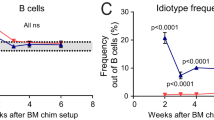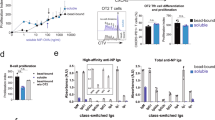Abstract
STUDIES in mechanisms of T–B collaboration in the immune response have shown that T cells can produce factors after stimulation with antigen1–3, allogeneic cells4–6, or mitogens (ref. 7 and O. Sjöberg, unpublished), that can stimulate B cell responses to antigens. Such factors have been categorised as specific1,3 or nonspecific (refs 4–7 and O. Sjöberg, unpublished). Studies have shown that the specific factor produced by (T,G–A—L) stimulation of educated T cells8 is able to promote antibody formation by both syngeneic and allogeneic cells. Similarly, with one exception6, nonspecific factors from antigen- or mitogen-activated T cells were able to cooperate with B cells from histoincompatible strains7,9. Reports that histoincompatible T and B cells could not be demonstrated to cooperate in a humoral immune response10, in conditions in which it was consided that inhibitory allogeneic effects were excluded or irrelevant, indicated that for efficient collaboration T and B cells need to share surface determinants coded for by major histocompatibility complex (MHC), in particular the I region or its equivalent. One report11 argued against this;allophenic mice (C3H + C57BL) were able to make non-responder allotype towards (T,G)–A—L. This finding made the presumption that it was the high responder T cells which were collaborating with the low responder B cells, but could not exclude that alternative cooperative mechanisms were operational.
This is a preview of subscription content, access via your institution
Access options
Subscribe to this journal
Receive 51 print issues and online access
$199.00 per year
only $3.90 per issue
Buy this article
- Purchase on Springer Link
- Instant access to full article PDF
Prices may be subject to local taxes which are calculated during checkout
Similar content being viewed by others
References
Feldmann, M., and Basten, A., J. exp. Med., 136, 49 (1972).
Waldmann, H., and Munro, A. J., Nature, 243, 356 (1973).
Taussig, M. J., Nature, 248, 235 (1974).
Schimpl, A., and Wecker, E., Nature new Biol., 237, 15 (1972).
Dutton, R. W., et al., Progr. Immun., 1, 355 (1971).
Armerding, D., and Katz, D. H., J. exp. Med., 140, 19 (1974).
Waldmann, H., Poulton, P., and Desaymard, C., Immunology (in the press).
Taussig, M. J., Munro, A. J., Campbell, R., David, C. S., and Staines, N. A., J. exp. Med. (in the press).
Lefkovits, I., Quintans, J., Munro, A. J., and Waldmann, H., Immunology, 28, 1149 (1975).
Katz, D. H., Hamoaka, T., and Benacerraf, B., J. exp. Med., 137, 1405 (1973).
Bechtol, R. B., Freed, J. H., Herzenberg, L. A., and McDevitt, H. O., J. exp. Med., 140, 1660 (1974).
von Boehmer, H., Sprent, J., and Nabholz, M., J. exp. Med., 141, 322 (1975).
Lefkovits, I., Eur. J. Immun., 2, 360 (1972).
von Boehmer, H., Hudson, L., and Sprent, J., J. exp. Med. (in the press).
Heber-Katz, E., and Wilson, D. B., J. exp. Med., (in the press).
Waldmann, H., Immunology, 28, 497 (1975).
Author information
Authors and Affiliations
Rights and permissions
About this article
Cite this article
WALDMANN, H., POPE, H. & MUNRO, A. Cooperation across the histocompatibility barrier. Nature 258, 728–730 (1975). https://doi.org/10.1038/258728a0
Received:
Accepted:
Issue Date:
DOI: https://doi.org/10.1038/258728a0
This article is cited by
-
The influence of thymus on the development of MHC restrictions exhibited by T-helper cells
Nature (1979)
-
Influence of the major histocompatibility complex on lymphocyte interactions in antibody formation
Nature (1978)
-
Products of the major histocompatibility complex and their relationship to the immune response
Nature (1976)
-
Helper T cells recognize antigen and macrophage surface components simultaneously
Nature (1976)
Comments
By submitting a comment you agree to abide by our Terms and Community Guidelines. If you find something abusive or that does not comply with our terms or guidelines please flag it as inappropriate.



